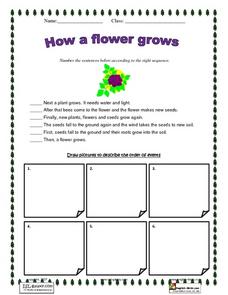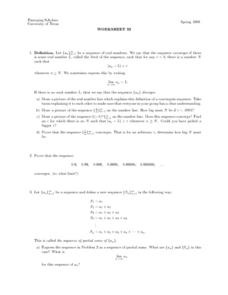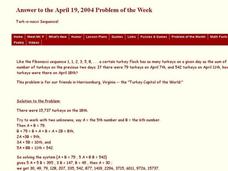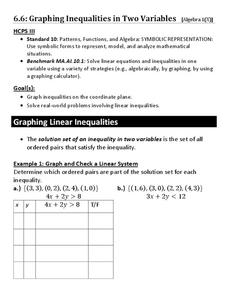Curated OER
The Algebra of Summation Notation
In this algebra worksheet, learners use the summation notation correctly as they solve problems. They define the integral of a function and solve problems involving i. There are 14 questions with an answer key.
Curated OER
How a Flower Grows
English Language Learners demonstrate their ability to sequence the steps in a process. After reading six sentences that describe how a flower grows, learners identify the right sequence and illustrate the steps. An answer key is provided.
Curated OER
Worksheet 32 - Sequence
In this sequence worksheet, students explain the definition of a convergent sequence and draw models of sequences. This two-page worksheet contains four multi-step problems.
Curated OER
Worksheet 33 - Sequence
In this sequence worksheet, students find the limits of given sequences and prove theorems. This one-page worksheet contains four multi-step problems.
Curated OER
Worksheet 6 - Improper Integrals
In this improper integral worksheet, students determine the convergence or divergence of functions. They explore the sequence in the series. This one-page worksheet contains six multi-step problems.
Curated OER
Square & Rectangular Numbers
For this number pattern worksheet, students respond to 4 multi-step questions that regarding square and rectangular numbers as well as the number patterns associated with them.
Curated OER
Fibonacci Trick
In this algebra worksheet, students solve a puzzle starting with two single digit numbers and eventually conclude that the answer can be used with Fibonacci's pattern. There are 11 steps to the puzzle with a provided answer.
Curated OER
Identify the Pattern to Find the Letter to Replace the ?
In this problem solving puzzle, students identify the pattern to find the letter that should be placed in the box with the ?. The solution is provided.
Curated OER
Turk-o-nacci Sequence
In this sequence worksheet, learners use the Fibonacci sequence to determine the number of turkeys in a flock. This one-page worksheet contains 1 multi-step problem. The answer is provided at the bottom of the page.
Curated OER
Divide Decimals by Decimals
In this dividing decimals worksheet, students review and observe examples, continue patterns, and multiply the dividend and divisor in each step by ten, so that the quotients remain the same. Students solve three problems.
Math Worksheets Land
Patterns of Association (Using Data Tables) - Step-by-Step Lesson
This worksheet belongs to a four-part resource that gathers information from data tables to calculate percentages. The page introduces one problem and shares an explanation to the answer.
Curated OER
Using Patterns
For this math worksheet, 6th graders use the time at home in order to work on the skill of recording data in the form of daily activities and statistics.
Curated OER
Trigonometry Practice Series #3
In this trigonometry worksheet, students calculate the sum of the terms in an arithmetic and geometric series. This two-page worksheet contains 5 multi-step problems. Answers are provided at the bottom of the page.
Curated OER
Incomplete Dominant and Codominant Traits Worksheet
A two-page instructional activity provides seven Punnett squares for practice in determining genotypes and phenotypes. Each is an example of incomplete dominance or codominance. After your bright biologists have mastered Punnett squares,...
Willow Tree
Linear Relationships
There's just something special about lines in algebra. Introduce your classes to linear equations by analyzing the linear relationship. Young mathematicians use input/output pairs to determine the slope and the slope-intercept formula to...
Curated OER
Solving a Simple Maze
It is a-maze-ing how lost one can get. Teams reconstruct a simple maze and solve it. Participants create an algorithm that a robot would follow in order to solve the maze as well. The activity includes an extension directing pupils to...
Curated OER
A Piece of Pi
In this piece of Pi activity, learners examine pi. They count how many times a given digit appears in the list of digits. Students describe their observations and conclusions regarding pi. This one-page...
Virginia Department of Education
Solving Equations
Demonstrate the abstract process of solving equations by using algebra tiles as a concrete representation. Scholars begin by solving equations through the use of manipulatives. As they gain more confidence, they progress to...
Curated OER
Graphing Inequalities in Two Variables
This study guide is a great resource to help you present the steps to graphing linear inequalities. Show your class two different ways to graph an inequality and work on a real-world example together. The document could also be easily...
Curated OER
Weighted Averages
Weighted averages can be tricky to explain! However, this study guide makes it easy for teachers by including definitions, explanations, and breaking down problems into three steps. Includes mixture problems and uniform motion problems.
Illustrative Mathematics
Seven to the What?!?
Sometimes what seems like the easiest problem is really the most difficult. Your class is first going to reach for their calculators, but will realize the number is too large to evaluate. Now what? This is where the fun and the...
Teach Engineering
Earthquakes Living Lab: Locating Earthquakes
There are patterns in nearly everything — even earthquakes. Pairs research current earthquakes to see if there are any patterns. They determine the mean, median, and mode of the earthquake data, along with the maximum and...
Willow Tree
Line Plots
You can't see patterns in a jumble of numbers ... so organize them! Learners take a set of data and use a line plot to organize the numbers. From the line plot, they find minimum, maximum, mean, and make other conclusions about the...
Concord Consortium
Boards I
Learners create patterns in a table to mimic the function of an electronic spreadsheet. The result is a table that creates an addition table for decimals in intervals of one-tenth. While creating the pattern, pupils must thoroughly...

























